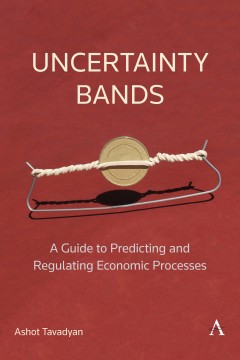Uncertainty Bands: A Guide to Predicting and Regulating Economic Processes
By Ashot Tavadyan
Other Formats Available:
E-Book- About This Book
- Reviews
- Author Information
- Series
- Table of Contents
- Links
- Podcasts
About This Book
This book explores the philosophy of economic forecasting under uncertainty. In economics the extreme events are difficult and often impossible to predict, especially when leaning upon the past only. Events can be approximately evaluated, as they may be sudden and erratic. The presentation of programs for years ahead is of little value because the uncertainty intervals expand when economic volatility increases, forming uncertainty bands. This book presents the effect of an expanding uncertainty band.
This book reasons that the economic system has sensitivity thresholds - critical states of economic processes at which they significantly alter their characteristics. In those critical states, economic phase transitions may occur. A slowdown in economic growth, especially a tangible recession, can result in negative qualitative changes in the economy, which can have a long-term impact. As in medicine, in economics, the diagnosis must not be rigid and permanent. Vital indicators could and will change throughout therapy. A rigid forecast resulting in an attempt to ensure the rigid stability of indicators is dangerous and fraught with irreparable economic losses.
To solve the issue of inflexible programs, this book presents the minimal uncertainty interval. This method is to open a logical path from the predicament of explaining its quantitatively precise indefinability of the indicators. The aim is to contribute to the flexible and realistic concept about possible dynamics of economic processes with interval forecasts and probabilistic evaluations of those events’ outcomes. It is indicated that exiting the allowable intervals of regulatory indicators contributes to the emergence of economic diseases. This book tries to explore and systematize economic diseases, presents the factors that affect forecast efficiency, and makes the forecast satisfactory. Based on the systematization of the conducted research, this book formulates the ten principles of forecasting, which are necessary for forecasting the economic processes and decision-making under uncertainty.
Reviews
“Professor Tavadyan has written an interesting book about the philosophy of economic forecasting investigating its connection to uncertainty and warning about the unpredictability of the economic landscape and the need to consider the ‘uncertainty band’ in all decisions related to economic predictions.” – Professor Spyros Makridakis, University of Nicosia UNIC, director of the Institute for the Future IFF, Cyprus.
“This is a splendid book, explaining to a wide readership some of the difficulties of making economic predictions. In doing so, it can help reduce the pressure on economists to provide estimations they cannot substantiate.” – Professor Itzhak Gilboa, Professor Economics and Decision Sciences, HEC Paris, France.
“Ashot Tavadyan has written an excellent book on a crucial topic. Mainstream economics is very poor at dealing with uncertainty, often with catastrophic results. Professor Tavadyan introduces a viable and practical methodology for dealing with this uncertainty.” – Nick Silver, managing director of Callund Consulting Limited, founder and director of Climate Bonds and Radix, visiting fellow at the London School of Economics and Bayes Business School, and lecturer at Trinity College Dublin and City University, UK.
“In his captivating book ‘Uncertainty Bands’, Prof. Tavadyan introduces new grounds for economic forecasting. This is especially important for extreme and foreseeable events when the existing methods of prediction are irrelevant. The book is very timely. Given the volatile state of the world nowadays, this book is a must-read for politicians, businessmen, statisticians, and economists.” – Professor Moawia Alghalith, Department of Economics, UWI, WI.
"Policy-makers and other economic actors need to form some view of the future even if it is only about how uncertain the future is. This book addresses this need, exploring ways of forming expectations under uncertainty beyond formal modeling. In the process, Ashot Tavadyan explains the limitations of conventional prediction methods applied to a complex evolving reality." – Professor Sheila Dow, Emeritus Professor, University of Stirling, USA.
"The book is a refreshingly expository volume on Uncertainty Bands, exhorting the readers with the warning that ‘Equilibrium can be dangerous’. Economic indicators are forecast within intervals of relevance - and outside they are either ‘quackeries’ or ’tautologies’. This attractive and readable book encompasses much - like the business cycle - and achieves what it sets out to do, i.e., show the relevance, for forecasting, of considering intervals for predictions; no fine-tuning in this finely crafted book." – Professor Vela Velupillai, Senior Visiting Professor at the Madras School of Economics, India.
"With his book, Ashot Tavadyan succeeds in rethinking the principles of uncertainty in economics. Uncertainty is the new normal in economic ontology and the necessary assumption for shaping economic policy in the coming decade. We expect the unpredictable. In the future, successful economic policy will arise through creativity, will and rigorous critical thinking in discourse. It will no longer be possible to derive conclusions about the future from the past. The principles of uncertainty are both menacing and necessary to moving forward in economics." – Dr. Julia Köhn, digital entrepreneur, philosopher and economist.
Author Information
Dr. Ashot Tavadyan is member of the Russian Academy of Natural Sciences, member of the International Information Academy of Canada, First Chairman of the Control Chamber of Armenia, Head of Center for Economic Research, Editor-in-Chief of Armenian Economic Journal, NAS RA, Head of Department of Mathematical Methods and Information Technologies in Economics and Business, Russian-Armenian (Slavonic) University (RAU)
Series
Anthem Impact
Table of Contents
Preface; Introduction – The Philosophy Of Economic Forecasting; Chapter 1 – Interval Links in Economy and the Capabilities of Quantitative Thinking; Chapter 2 – The Possibilities for Forecasting Economic Indicators; Chapter 3 – The Principle of the Minimal Uncertainty Interval; Chapter 4 – The Intervals of Key Economic Indicators; Chapter 5 – Key Principles of Economic Regulation; Conclusion; Appendix – The Uncertainty Relations of Economic Indicators; Acknowledgments.
Links
Stay Updated
Information
Latest Tweets



